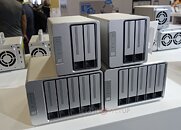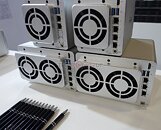- Joined
- Oct 9, 2007
- Messages
- 47,680 (7.43/day)
- Location
- Dublin, Ireland
| System Name | RBMK-1000 |
|---|---|
| Processor | AMD Ryzen 7 5700G |
| Motherboard | Gigabyte B550 AORUS Elite V2 |
| Cooling | DeepCool Gammax L240 V2 |
| Memory | 2x 16GB DDR4-3200 |
| Video Card(s) | Galax RTX 4070 Ti EX |
| Storage | Samsung 990 1TB |
| Display(s) | BenQ 1440p 60 Hz 27-inch |
| Case | Corsair Carbide 100R |
| Audio Device(s) | ASUS SupremeFX S1220A |
| Power Supply | Cooler Master MWE Gold 650W |
| Mouse | ASUS ROG Strix Impact |
| Keyboard | Gamdias Hermes E2 |
| Software | Windows 11 Pro |
TERRAMASTER is democratizing 10 GbE in the consumer NAS space through aggressive cost-optimization. For small businesses, 1 GbE is no longer an acceptable network bandwidth in which multiple desktops are working on shared resources. The new F5-422 from TERRAMASTER is a 5-bay small-business NAS with a fat 10 GbE pipe, which enables data transfer-rates of up to 670 MB/s to your local network. It also features two additional 1 GbE ports with link-aggregation as a fallback. Its caddies are designed to support both 3.5-inch and 2.5-inch SATA drives, without the need for adapters.
Under the hood, the F5-422 is powered by an Intel "Apollo Lake" quad-core x64 SoC (likely the Celeron J3455), running at 1.50 GHz, with 4 GB of memory that's expandable to 8 GB. The NAS supports 80 TB of total storage, or up to 16 TB per disk. It uses an aluminium alloy body with a noise-optimized single fan. TERRAMASTER's TOS 4.1 software provides a browser-based UX for the NAS. The F5-422 is priced at $600. Next up, is a new family of RAID DAS (disk-attached storage) solutions featuring Thunderbolt 3 (40 Gbps), targeting creative professionals working on large data-sets that need to be redundant and secured. TERRAMASTER's DAS lineup is based on a common hardware platform that features up to 1,600 MB/s of throughput, and supports up to 128 TB of aggregate storage. Models range from 2-bay, to 4-bay, 5-bay, and large 8-bay towers. These units feature aluminium-alloy bodies with grab-handles on top and 1 or 2 low-noise fans, depending on the model.





View at TechPowerUp Main Site
Under the hood, the F5-422 is powered by an Intel "Apollo Lake" quad-core x64 SoC (likely the Celeron J3455), running at 1.50 GHz, with 4 GB of memory that's expandable to 8 GB. The NAS supports 80 TB of total storage, or up to 16 TB per disk. It uses an aluminium alloy body with a noise-optimized single fan. TERRAMASTER's TOS 4.1 software provides a browser-based UX for the NAS. The F5-422 is priced at $600. Next up, is a new family of RAID DAS (disk-attached storage) solutions featuring Thunderbolt 3 (40 Gbps), targeting creative professionals working on large data-sets that need to be redundant and secured. TERRAMASTER's DAS lineup is based on a common hardware platform that features up to 1,600 MB/s of throughput, and supports up to 128 TB of aggregate storage. Models range from 2-bay, to 4-bay, 5-bay, and large 8-bay towers. These units feature aluminium-alloy bodies with grab-handles on top and 1 or 2 low-noise fans, depending on the model.





View at TechPowerUp Main Site



